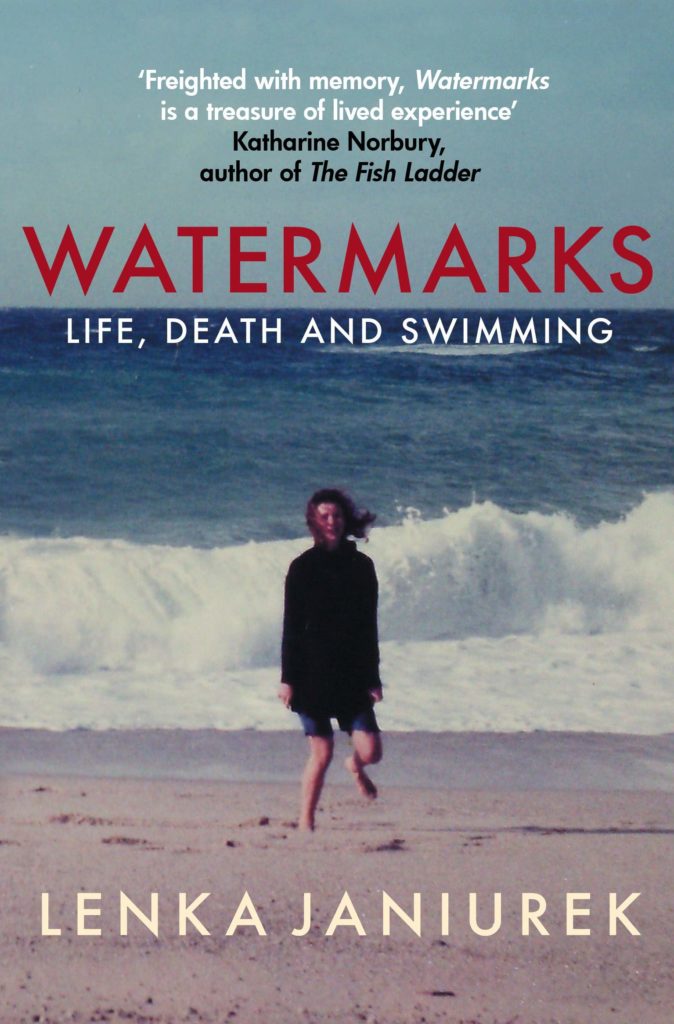Involving a chaotic family, early success as a playwright, disastrous relationships, motherhood, and brushes with both extreme wealth and poverty, Lenka Janiurek’s rich memoir ‘Watermarks: Life, Death and Swimming’ — out today in paperback via Allison & Busby — explores her search for a kind of freedom, found in the comforting solace of swimming. The following extract comes from the chapter titled ‘Bay’.

The whole sky is open to clarity, and perspective, the whole bay is spread out in front of us. Our tents are somewhere right down over there. We have arranged ourselves in various locations around Pentre Ifan, the burial chamber, in character. Frank has climbed up, Lily is stretched out on a flat rock, Amba is under the cromlech looking up, examining it. The pimple of the mountain is framed by the stones that barely touch, yet hold the weight of the monolithic capstone. It’s megalithic, it’s mega. This is a place of both music and silence. We don’t feel like tourists, we forgot the camera anyway. We feel as though we have returned, because everything here feels familiar. It knows us and we know it. It’s two-way. Maybe somewhere here is where we need to be.
Sunset is coming on August Bank Holiday. The tide is creeping in and in, up and up. We’re all swum out on the beach, our damp clothes clinging to our damp skins as we swarm around a flask of steaming chai. And then tear baguettes apart, dunking them in the jar of olives and sun-dried tomatoes, stuffing them dripping with oil into our mouths as if our lives depend on it. Today there are cars and vans parked close together. It’s crowded, there are people everywhere, lighting fires in the dunes, boiling kettles on stoves in vans, eating chips from town and waiting, clustering, looking out, over to the mountain, at the first stars coming out, at the bowl of the estuary at twilight. At the moon rising. And we wait too, not sure why we are here.
With darkness the display begins. In the future, health and safety regulations and insurance concerns will put a stop to all this, but now the pyrotechnic who designs firework displays all over the world, including for the Queen, dazzles this messy whooping oohing and aahing crowd of tourists and smallholders, cabin dwellers and permaculturists, babies on shoulders, teenagers on drugs. The tide keeps coming in like a thief in the night behind us, because we are all turned the other way, gazing at the purples and reds and sprays of diamonds and trails of snakes. And it’s hard to know whether to concentrate on the sky, where the fireworks explode and dart and shimmer before they dissolve, or the water, where all this is reflected as if in another world, a mirror of this one. I feel like I live here already, in both. I am not trapped. And behind us the tide creeps up, reaching the wheels of cars and vans, but the fireworks have taken over the landscape, the waterscape, the headspace. There is the scent of woodsmoke and home-grown weed.
The tide doesn’t care about people or fireworks. The tide doesn’t care about vehicles, the tide waits for no one, ignores everything. So when it’s all over, the show, the banging, crackling, sky-shattering extravaganza, there are people arguing, children wailing, as they try to get their vehicles out while the sea laps round their ankles. The sensible people parked up on the hill by the golf club. The patient sit and wait it out: the tide, the crowd, the panicking, this weird traffic jam in the middle of nowhere. We are quite by chance sensible and patient. We look out to sea again, and back at the mountain and the shadows of the boats bobbing up and down in the water as the estuary fills up. We look at the moon looking back. Knowing we are in some kind of allegory, up to people’s ankles, knowing that (for now) the tide always turns.
*
We have three paperback copies of ‘Watermarks’ to give away on tomorrow’s newsletter, kind courtesy of the publishers. Make sure you’re signed up to our mailing list for details of how to enter! The sign-up bar can be found in the top right of this page.